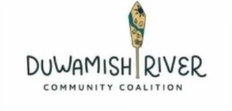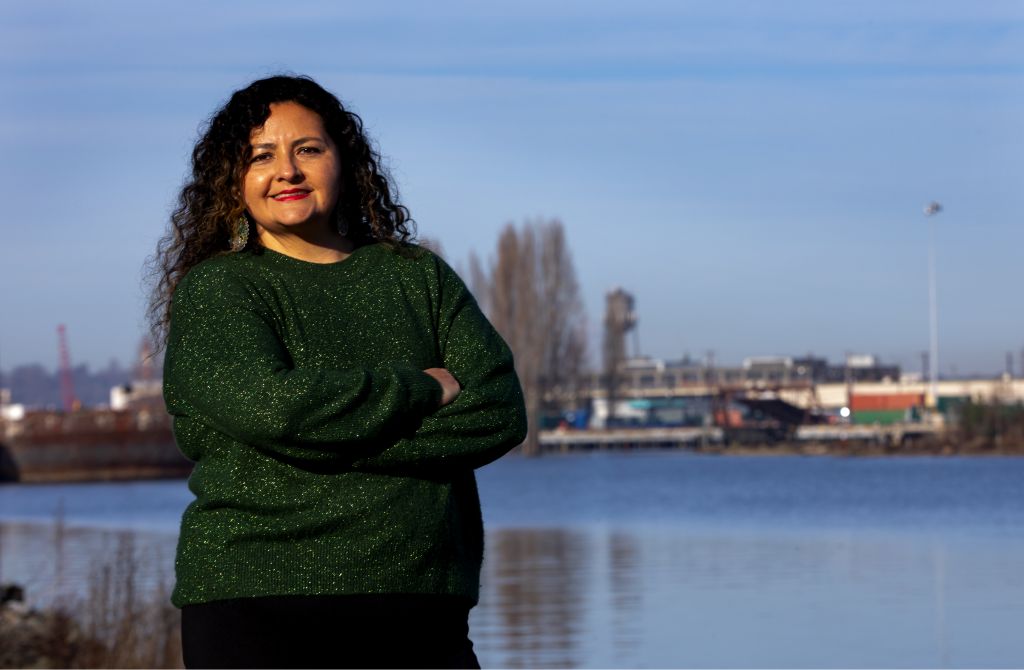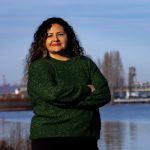Paulina López
Executive Director
Duwamish River Community Coalition
Paulina López is a volunteer, organizer, advocate, and mother of three boys. Originally from Ecuador, she has made Seattle her home for 19 years. Presently, she is the Executive Director for the Duwamish River Community Coalition (DRCC), advocating for communities to have a voice in complex decision-making processes. Paulina has over 20 years of experience working to advance civil rights, social justice, equity, education, and diversity. She has served in several community organizations that foster civic engagement among recent immigrants, and has labored extensively to promote social and environmental justice issues uniquely affecting recent immigrant communities. Paulina has a passion for community engagement, especially for underrepresented communities on issues they have identified as priorities.
In her time working with DRCC, Paulina has led diverse outreach campaigns that generated overwhelming community support for stronger cleanup efforts in the Duwamish River (which is a Superfund Site), worked with the Green-Duwamish Watershed Urban Waters Federal Partnership to launch the Duwamish Valley Youth Corps, and relaunched the Duwamish Valley Clean Air Program with community and youth-led science.
Paulina is an active member of the Urban Waters Learning Network (UWLN); and, she received an UWLN Award in 2019.
I talked to Paulina on January 19, 2022 to learn more about her background and her work. This interview was edited for length and clarity.
Tell me about your role as the Executive Director of Duwamish River Community Coalition.
I started two years ago as the Executive Director, but I have been involved with the organization for more than 10 years. I started as a volunteer because I live in the neighborhood. I was always linked to the rivers, even since my days back when I came as an immigrant from Ecuador. I have always been linked to the water, to indigenous rights, to human rights. I really believe in the work that we’re doing, involving community members to make sure that their voices are represented in the cleanup of the river.
The name of the organization was originally the Duwamish River Cleanup Coalition and Paulina explains why the name changed since she’s been the Executive Director.

The new logo for DRCC represents and honors the first people of the land—the Duwamish People.
We have changed the name to Duwamish River Community Coalition. We wanted to center Community rather than Cleanup. We are bringing the intersections of the river cleanup with air pollution and the impacts that it has on health as well as advocacy for place keeping…and making sure that communities are not being displaced. That is why we centered the community in the name of the organization.
We just launched [a new] logo this year for the 20th anniversary [of the organization], bringing awareness of the first people of Seattle…how we honor their land, their water…All of this is represented on the paddle in the logo.
Listen to the audio clip above to hear Paulina describe the new logo and the significance of the images in the paddle.
How did you come into this kind of work?
I have always been interested in the work of social and environmental justice. I started to be involved back home in Ecuador. I was working with indigenous communities in the south and east of Ecuador. We were bringing students from the university where I worked and studied—Pontifical Catholic University of Ecuador. With the community, we prioritized where they wanted to see development work, and then we brought students to help the local community succeed by either building or by developing plans that would help them get to their vision of self-determination. That’s how I started.
To further my studies, I moved to the United States. I was invited by Columbia University in New York to work with other leaders around the world.
Paulina stayed and completed a master’s degree in human rights law.
That confirmed my interest in directly working with communities that were going through human rights, environmental, and social injustices. After [completing the degree], I moved to the Pacific Northwest. I always thought that I would apply my knowledge to the work that I was doing back home. When you’re from another country, the US is a model of agreements and signing onto human rights solutions. But, when I came to South Park and the Duwamish Valley in general, I just couldn’t understand these inequities that were happening in my back yard…having 13 years life expectancy difference with a neighbor 10 miles away. To me, it was a big shock. I decided to stay to understand better these inequities and further the work here. I started to understand – redlining, communities of color and impacts – it was very similar to what I was seeing back home. I was very disappointed, in fact, to agree that this is happening in one of the most developed countries in the world. I stayed, and I’ve been involved since then. I never moved out of this neighborhood because I had in my mind: Until this makes a difference and a change, I’m going to be involved.
Is there any project that you’re currently working on that you’re feeling quite passionate about?
Right now, something that is drawing a lot of our energy is the importance of working with the community about the triple threat that we see in the river…to be clean to the standards of what the community asked for. The EPA is trying to do a cleanup right next to the Duwamish River in the East Waterway without community consultation; and we totally see that this will lower all the standards that we have worked for the past 20 years on in the Duwamish, because they are seen as two different Superfund Sites. It is unfortunate that they are making these decisions that are going to be impacting an environmental justice community that has already been impacted by so many other environmental injustices. They are not considering cumulative impacts of what the river already has, which is weakening the cleanup levels by approximately 15 times…compared to what we have in the 2014 Lower Duwamish Cleanup Plan. We are applying to be a possible TAG (Technical Assistance Grant) recipient for the East Waterway…we already have a TAG for the Duwamish… they don’t see the connection. But, it’s the same body of water – the fish will be crossing, there is no line when the salmon are crossing – impacting the immigrant fishers the most. So, we are trying to make the community understand the impacts. And, we’re meeting with the EPA, elected officials, and responsible parties…beyond the scope of the Duwamish.

Image: Duwamish River Community Coalition
We’re also busy working with the community as we launch our clean air strategy for the Duwamish Valley. We’ve been working with 40 different partners from government to community organizations and community individuals to make sure that we are representing the best actions. We’ve been working to develop a plan that would allow for us to be tracking progress, and most importantly, to keep people that are responsible for all these actions to be accountable. We have 52 recommendations and among them, the most important ones are: (1) decreasing emissions in the Duwamish Valley, (2) reducing industry, construction and construction pollution, (3) improving indoor air quality, and (4) improving outdoor quality through physical environmental changes. Right now, there are no strong laws in Washington state to protect us from emissions, so we are working on policy and legislation… as well as advocating for more electrification, focusing on maintaining tree canopy, and bringing air monitors into the area.
Can you share your experiences from attending the Urban Waters Learning Forum and River Rally?
My first experience was very eye opening. There were so many amazing organizations that are doing similar work. It felt good to be in [the] company of others doing the same work. I see it as a great resource to find and meet other leaders around the country that are working towards the same issues… [they] also bring expertise and knowledge sharing of things that are working already for some of them. We did a presentation [at River Rally] about how to create a youth program, and it was very well-received. After, we were able to support an organization in creating sustainable youth programming. So, it has always been an opportunity to appreciate and honor the work that other organizations like ours are doing.
What keeps you motivated in this work?
Our youth and our community. I think, every time when we’re out with the youth doing work, I keep on thinking, all this work that we’re doing, hopefully, they will be the beneficiaries of the advocacy we’re doing. And, they will have a better future, they will have a better community.
Listen to the audio clip above to hear Paulina describe what keeps her motivated.


